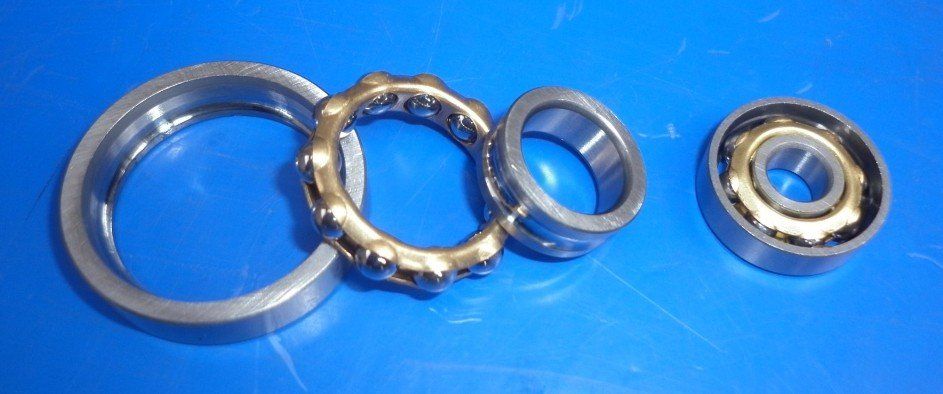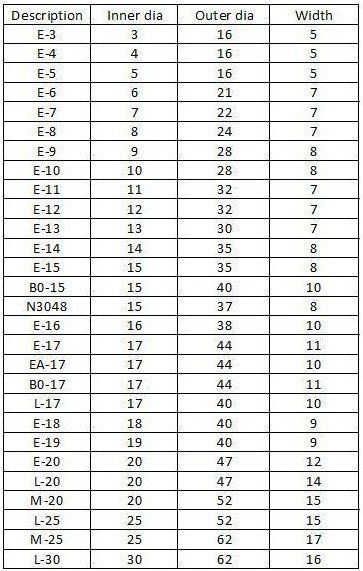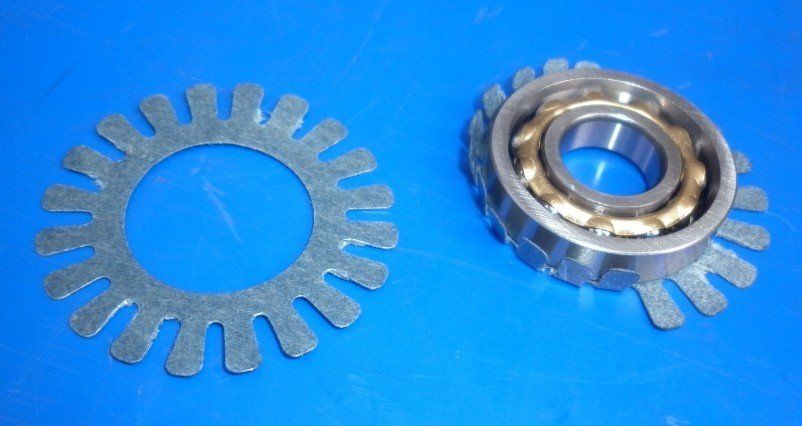Magneto Bearings
Magneto Bearings
Single Row Deep Groove Ball Bearings are the most commonly used rolling bearings. The balls run in deep grooves in both the outer and inner rings. This enables the bearing to accommodate radial loads as well as some axial loads in either direction.
Magneto bearings have an internal design similar to the single row deep groove ball bearings but with two major differences:
1: The outer race has a shoulder on only one side which allows it to be easily removed from the rest of the bearing
2: The groove on the inner race is a little shallower than that of deep groove bearings so that, with the outer race already removed, the balls in their cage can be removed from the inner race
2: The groove on the inner race is a little shallower than that of deep groove bearings so that, with the outer race already removed, the balls in their cage can be removed from the inner race

The bearing is then separated into three component parts which makes assembly of the magneto much easier.
In the majority of applications, two magneto bearings are used as a pair. The outer races are pressed into the magneto housings so that the open sides of the races face each other and the inner races are pressed onto the armature shaft. The cage with the balls can then be replaced onto the inner races. The armature is placed into the magneto body, thereby assembling one bearing. The end housing with the other outer race is then placed over the armature shaft and into the magneto body thereby assembling the second bearing. Keeping a constant check on the armature to ensure that the bearings are not over tightened, the end housing screws/nuts are put in place. If the bearings do start to go tight because there is not enough end float, a large shim is placed between the magneto body and the end housing to move the outer races further apart. If, once the screws/nuts are done up tight, there is too much end float, the armature is removed and shim(s) placed under one of the inner races to move the inner races further apart. Once the correct end float is achieved, the armature is removed again so that the bearings can be greased before everything is assembled for the last time.
Correct end float in a magneto is an important consideration. Tight bearings would obviously be a problem but too much end float can also create problems. Loose bearings will allow the armature to ‘float’. If it is excessive, this will allow the armature to rub on the pole pieces as it revolves. It will also affect the timing as the CB points (rotating coil magnetos) or the cam (rotating magnet magnetos) will be bouncing about resulting in variable ignition timing and erratic running. Too much end float is especially a problem with magnetos using a face cam arrangement to open the points as axial movement of the armature will change the points gap setting and therefore the timing.
We always assemble magnetos with ‘next to nothing’ in the way of end float - just perceptible play of one or two thou. When they are working, magnetos will inevitably get warm and as a result, they will expand a little. The aluminium body will expand more that the steel/brass armature so, as it warms up, end float will increase slightly.
Magneto bearings are usually lightly loaded and so will last a long time if kept adequately lubricated. However, they do wear and this will show up as increased end float. The end float could be re-adjusted as outlined above but this would be false economy. Adding a shim to the armature would appear to take up the end float but the balls will not be seated properly in the grooves – the end float will soon re-appear.
Magneto Bearing Dimensions
The descriptive names listed below are the most common and are used by several different manufacturers. However, some manufacturers use/used different markings. For instance the E15 bearing may be found with FB-15, E-15B, ND-15, N 15 and, no doubt, other variations too.

Bearing Insulators
On a rotating coil magneto, the primary and secondary coils are part of the armature and therefore rotate with it. Carbon brushes are used to make connections to these rotating coils. The slip ring and pick up brush allows a path for the secondary current to reach the engine via the HT lead and spark plug. The current in the primary coil reaches the magneto body via an earth brush. On most magnetos, this earth brush runs on the periphery of the brass end of the armature. There may be an earth brush in the back of the CB points plate, some magnetos have both.
The magneto bearings must be insulated from the body in order to make sure the primary current uses the earth brush(es) rather than passing through the bearing itself. If this was allowed to happen, the bearing tracks and balls would rapidly become pitted resulting in premature bearing failure. The insulating washer is usually made in a star shape as shown in the diagram so that it fits underneath and around the outside of the outer bearing ring.

The Magneto Guys
Telephone: +44 (0)1323 840203
